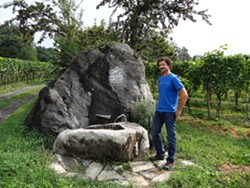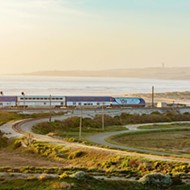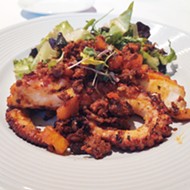Passionate about Pinot Noir
Enjoy Matthias and Sina Gubler Mohr's spectacular Swiss wines
By Kathy Marcks Hardesty[{
"name": "Ad - Medium Rectangle CC01 - 300x250",
"id": "AdMediumRectangleCC01300x250",
"class": "inlineCenter",
"insertPoint": "8",
"component": "2963441",
"requiredCountToDisplay": "12"
},{
"name": "Ad - Medium Rectangle LC01 - 300x250",
"id": "AdMediumRectangleCC01300x250",
"class": "inlineCenter",
"insertPoint": "18",
"component": "2963441",
"requiredCountToDisplay": "22"
},{
"name": "Ad - Medium Rectangle LC09 - 300x250",
"id": "AdMediumRectangleLC09300x250",
"class": "inlineCenter",
"insertPoint": "28",
"component": "3252660",
"requiredCountToDisplay": "32"
}]
The first time I interviewed Swiss-born winemaker Matthias Gubler at Vina Robles, I’m certain I never imagined that more than a decade later I would visit him at his winery in Maienfeld, Switzerland. Yet after a speedy one-hour train ride from Zurich, my husband Dan and I were climbing into Matthias’ car and headed toward his vineyards. I’ll never forget that spectacular backdrop of the towering, snow-capped Swiss alps behind the ripening Pinot Noir hanging on the vines. There we learned that Stellibofel Vineyard grows his Pinot Noirs, and it was one of the most beautiful vineyard settings we have witnessed anywhere.
Once we left the highway, we sped along tiny roads that seemed too small for one car let alone two, yet passed one van with careful maneuvering. We were headed to Buendner Herrschaft, a wine region with four villages: Flaesch, Maienfeld, Jenins, and Malans. To better show the region, he drove us up to the mountain resort of Heidihof, where the novel Heidi was written. The location provided a panoramic view of several communities and vineyards nestled along the mountain range.
In the beautiful small town of Maienfeld you’ll find Möhr-Neggli vineyards and winery, co-owned by Matthias and Sina Gubler-Möhr. The latter name is her paternal side, and Neggli is Sina’s maternal side; both families built the estate that has four acres of vineyards with 10- to 30-year-old vines. Most roads in the wine region (an appellation in the U.S. AVA, American Viticultural Area) named Graubuenden, which has 1,000 acres, are lined with ancient 4-foot-tall stone walls. Matthias explained that when the farmers worked the land, they had to do something with all of the stones, and most were large. In the vineyards within Maienfeld, some stone walls were taller than six feet.
This was our first trip to Swiss wine country, and it was reminiscent of our previous visit to France when we visited Burgundy (renowned for producing the world’s greatest Pinot Noirs and Chardonnays).
At the vineyard, we strolled amid the perfectly maintained vines. There were many grape clusters on the ground, discarded because they weren’t of the quality he demands. It was exactly as I expected from a passionate man who describes himself as a “wine grower,” not a winemaker.
“We have 2.3 hectares, two hectares of Pinot Noir and .3 hectares of Pinot Blanc. We don’t make much white wine,” Matthias explained. “The vineyard rises from elevations of 1,600 to 1,900 feet. This area is what we call the small world of great wines. Pinot Noir is the masterpiece.”
Unlike working at a larger winery, which they did at Vina Robles, Matthias and Sina do everything themselves, from the vineyard management to the winemaking. Matthias said he enjoyed an interesting job at Vina Robles where he worked from 1999 until spring 2012.
“Here it’s more labor intensive. We get some help from our in-laws, and we have 25 friends and relatives to help with the hand picking at harvest,” Matthias noted.
They produce three different Pinots, all of which sell out each year.
He noted that there are a few wineries around him that make mostly white wines. Swiss wineries originally used German names for wine varieties, like Pinot Noir and Pinot Blanc, but now mainly use French names as we do in California. Although the Swiss have regulations for wine production, they aren’t nearly as rigid as the French rules. He explained the two important guidelines: Vineyards may not be planted on the valley floors, only higher elevations; and the wineries must limit the amount of Pinot Noir grown to four tons an acre, and white wines are limited to five tons an acre (Europeans use hectares to measure vineyards, but Matthias often said acres. I’m using the term as he did throughout the interview).
“You can make very good wine at four tons as long as the vines are healthy,” he added. “We prefer yields of 2.5 tons.”
Many wineries in the region make such white wines as Riesling, Pinot Gris, and Sauvignon Blanc, but they tend to be more acidic, Matthias admitted. He prefers growing Viognier and Pinot Blanc, but only produces small amounts of both wines. He prefers Pinot Blanc as a drinking wine for its exotic flavors, green apple, and minerality. His entire production is devoted to estate-grown wines. We also enjoyed his dry Riesling-Silvaner, known as Muller-Thurgau in the United States. After the vineyard tour, Matthias and Sina graciously invited us to their home for an authentic Swiss lunch.
Both Swiss born, the couple first met in Piedmont, Italy, while visiting a winery. Sina relocated to Paso Robles with Matthias where she took a job at Vina Robles in 2007. In 2008, the couple made their first Pinot Noir from her family’s vineyard. They generously opened several of their wines to try, including that outstanding Pinot. It was lovely at just five years, layered in flavors, and impossible to resist when you love this classic variety like I do. The quality was so good, I would like to taste that wine in another five years, as it’s certain to age beautifully.
We enjoyed the “Riesling soup” made up of Riesling, broth, and cream; the thin soup was garnished with chives and bacon. The main course was described as a pasta-like dough stuffed with prosciutto pieces and wrapped with Swiss chard in a rich, buttery sauce by Matthias. I heard jingle bells and outside the window saw a quaint horse-drawn carriage cruising up the streets. Matthias said, “Tourists.” We, however, were thrilled we had a true taste of Swiss life. Möhr-Neggli wines can be found at World of Pinot Noir in March.
Contact New Times’ Cuisine columnist at [email protected].










